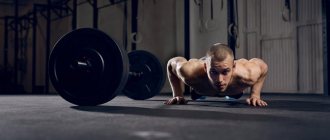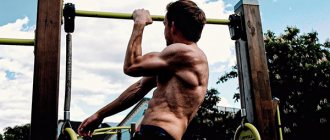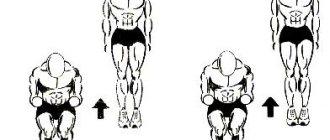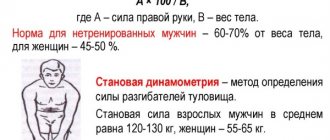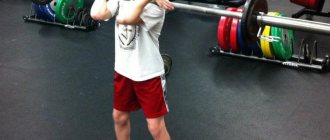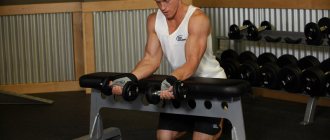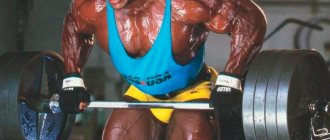Explosive strength is the body's ability to make maximum effort in the shortest period of time. This indicator is especially important in speed-strength and team sports - primarily sprinting, as well as in basketball and volleyball.
The basic movement for training explosive leg power is jumping. If you combine them with classic bodybuilding exercises, the training efficiency will be higher. In the material we tell you what are the benefits of jumping, and what else is needed to develop explosive leg strength.
What is explosive force?
This is the name given to a person’s ability to make a powerful jerk in the first seconds of movement. To develop explosive strength, it is important to “pump up” muscle endurance and power. “Explosive strength is important in many sports disciplines,” explains Stanislav Lysakovsky , an expert in X-Fit group programs in Russia. - Football, basketball, volleyball, boxing, weightlifting, tennis - everywhere power plays a vital role.
Developing this quality will allow you to run short distances faster, lift a heavy barbell, throw objects, and hit the projectile accurately.” But there are also those who do not need to develop explosive power. “This quality will not be useful for people in the older age category, those who want to reduce body weight, or those undergoing rehabilitation after injuries,” adds Stanislav Lysakovsky.
The essence of the method
The main idea of the training is the simultaneous activation of the maximum number of fast muscle fibers, the use of so-called “explosive strength” - the ability to exert the greatest effort in the shortest time.
At the same time, the nervous system is also loaded, which ensures a rapid response of muscle fibers to the signal to contract.
This method was developed and showed high effectiveness among Soviet athletes. Thanks to him, he was able to achieve high performance in sports such as running, swimming, football and volleyball, boxing, etc.
Combining strength and cardio, plyometric exercises are an integral part of any high-intensity training (HIIT).
What workouts develop explosive strength?
These can be exercises with weights (less often with your own weight), designed for fast, jerky movements. “Explosive exercises are characterized by heavy weights and maximum speed of execution. Due to this combination, their intensity falls into the category of maximum. Naturally, they require the strength of your ligaments, tendons, and muscles. And also - the attention of a fitness mentor, because the slightest mistakes in the technique can result in serious injury,” notes Stanislav Lysakovsky.
Training to develop explosive strength is not suitable for beginners: for this you must have a good level of physical fitness and well-honed technique for performing basic exercises.
Don't forget about other important points. “The most common mistakes when training explosive strength are poor execution, incorrect selection of weight and duration. All this will lead to injury, not to results,” says Stanislav Lysakovsky.
Execution Features
Before starting training, experienced athletes recommend warming up. If you plan to exercise for 45 minutes, at least 10 minutes should be spent on warm-up and stretching exercises. The main efforts are directed at the muscle groups that will have to experience the most significant load.
Rest intervals should be about 30 seconds between sets, since explosive running exercises do not particularly fatigue the muscles. After performing one exercise and before starting another, the warm-up time is 1-2 minutes.
When it is necessary to eliminate excessive tension, perform downhill running and slow running. To reduce the stress on the joints, if you have to perform jumps, you should choose a non-rigid surface for landing.
Each exercise is done in strict accordance with the technique of its implementation in order to avoid mistakes and injuries.
Thanks to explosive running, muscles are trained, toxins are eliminated, and organs are enriched with oxygen. After a successful run, the happiness hormones endorphin and serotonin are released, so your mood becomes positive. In addition, explosive running promotes the development of self-control, willpower, and determination. Forward!
https://youtu.be/bnXskgdwvzE
The main exercises for developing explosive strength
According to Stanislav Lysakovsky, these include:
Swing with a kettlebell. “It pumps up the leg muscles well,” the expert notes.
All strength exercises from weightlifting. “Deadlift, squat, lunge, barbell snatch,” lists Stanislav Lysakovsky. — The weight of the weight should be 60% of your maximum. Let's say you do one rep deadlift with a weight of 100 kg. Accordingly, for explosive exercises you will need a weight weighing 60 kg. Do the exercise with him at the maximum pace. The number of repetitions is 5-8, until the speed begins to drop. In this mode, you need to perform 4-8 approaches.”
Sprint from a standing start. “This is an exercise that everyone is familiar with from physical education lessons. Choose a distance of 100 meters and accelerate as hard as you can. And so - 8 times with an intermediate rest of half a minute,” says Stanislav Lysakovsky.
Exit by force. “This is a workout exercise,” comments Stanislav Lysakovsky. — Do a sharp stretch on the horizontal bar and continue moving upward. The goal is to rise with straight arms to the top of the horizontal bar. Then, in one motion, go down. Perform 5-8 reps or until speed starts to drop.”
At the initial stage, you can develop explosive strength without the use of weights, only through exercises with your own weight.
Testing[edit | edit code]
Testing the explosive power of a jump
The test consists of the athlete performing a jump in place: from a standing position he does a squat and then jumps up with maximum speed, so that he can stay in the jump for the longest time without touching the platform. Out of three attempts, the one with the best result is selected.
Calculation of muscle power using the Asmussen and Bonde-Petersen formula:[1]
Jump height (cm) = time between takeoff and landing (ms) × 1.226
Bosco Repeat Vertical Jump:[2]
jump height = 4.9 × (0.5 × Time)2
To assess explosive force, an ergometric platform can be used to plot a graph (change in pressure force over time):
Net impulse (dashed rectangle), total impulse (gray area). The higher the ratio of pure impulse to total impulse, the greater the explosive power of the Jump Phase
Bodyweight Explosive Strength Training
This complex was compiled by Corey Lefkovich, a personal trainer from California (USA), author of the YouTube channel Redefining Strength . It will help develop endurance and explosive strength, as well as work the muscles of the legs, back and arms.
How to build a lesson
- Start your workout with a short warm-up.
- Perform the exercises sequentially, following the instructions in the description.
- Do this program 2 times a week.
- Finish your workout with stretching.
Jump Squats
Stand straight, place your feet shoulder-width apart, and point your toes slightly to the sides. Bend your knees, push your pelvis back and lower into a squat. Touch your palms to the floor. Work your abs, legs and back muscles. From this position, jump up sharply and land, softening your knees. This is one repetition. Complete a maximum of these repetitions in 40 seconds.
Jumping with high knees
Stand straight, feet shoulder-width apart. Bend your arms slightly and hold them in front of you: palms at navel level. Jump up sharply, pulling your knees as close to your stomach as possible and trying to touch your palms with them. Actively work your abs and leg muscles. This is one repetition. Complete a maximum of these in 40 seconds.
Jumping jack with plyometrics
Place your feet slightly wider than your shoulders. Jump up, trying to spread your legs as wide as possible. At the same time, spread your arms to the sides. When landing, place your feet shoulder-width apart and bend your knees slightly. Repeat. Complete maximum repetitions in 40 seconds.
"Skater"
Stand straight, transfer your body weight to your right foot. Take a wide jump to the left, land on your left foot, take your right leg back and to the left, slightly lean your body forward. Then straighten up and make the same jump to the right, moving your left foot back and to the right. This is one repetition. Complete a maximum of these repetitions in 40 seconds.
Jumping lunges
Stand straight, feet shoulder-width apart. Step your right foot forward, lower your arms along your body. From this position, jump up, changing the position of your legs (now your left foot is in front) and raising your arms up. When you land, immediately bend your knees and lower yourself into a lunge, placing your arms along your body. From this point, straighten your knees and jump up again, changing the position of your legs. This is one repetition. Complete a maximum of these in 40 seconds.
Lunge Jumps
Stand straight, feet shoulder-width apart. Step your right foot forward, lower your arms along your body. From this position, jump up, raising your arms above your head. Actively work the muscles of the abs, thighs, legs and buttocks. Land and immediately lower yourself into a lunge, bending your knees to a right angle. This is one repetition. Complete a maximum of these in 40 seconds. Then change the position of your legs and do the same in the other direction.
Jumping with leg lifts
Stand straight, feet shoulder-width apart, arms along the body. Step your left foot back and, with your knees slightly bent, lower into a lunge. Then transfer your body weight to your right leg, push your left foot off the floor and lift your bent left leg in front of you, stretch your left knee up. From this point, jump up. Land and immediately move into a lunge. This is one repetition. Complete a maximum of these in 40 seconds. Then change the position of your legs and do the same in the other direction.
Bent Jumps
Stand straight, transfer your body weight to your right foot. Bend your left knee. Jump up. Landing on your right foot, lean your torso forward and extend your left leg back. Move your hands as if walking: alternately move your right and left forward. Actively work the muscles of your hips and back. This is one repetition. Complete a maximum of these in 40 seconds. Then change the position of your legs and do the same in the other direction.
"Skater" with plank
Stand straight, transfer your body weight to your right foot. Take a wide jump to the left, land on your left foot, place your palms on the floor, lean on them and jump your feet back. Place your left foot on your toes, moving into a plank, do not lower your right foot to the floor, keep it suspended. In the same jump, move your feet forward - the right one is still raised above the floor. Return to a vertical position, jump to the right, landing on your right foot, and repeat the entire chain of movements in the other direction. This is one repetition. Complete a maximum of these in 40 seconds.
Jumping and reverse crunches
Stand up straight with your feet together. Stretch your arms up. Jump up, working the muscles of your legs, back and abs. Then squat down, roll onto your back and lift your pelvis up, performing a reverse abdominal crunch. Roll forward again, rise up, stand straight and jump up. This is one repetition. Complete a maximum of these in 40 seconds .
Plank with jumps
Stand in a plank position with support on your forearms, actively work your abs, back and hip muscles. Place maximum weight on your arms and shoulders, relax your lower back. Using the muscles of your thighs and buttocks, jump your feet to the left, then to the right. This is one repetition. Complete a maximum of these repetitions in 40 seconds .
Plank rolls and push-ups
Squat down, then smoothly roll onto your back, lifting your legs off the floor. Then roll forward again and place your feet on the floor. Lean your body forward, squat down, lower your palms to the floor, lean on them and jump your feet back. Get into a plank position, then do a push-up. Then jump and place your feet closer to your palms and move to a squatting position. This is one repetition. Complete a maximum of these in 40 seconds .
Jump push-ups
Stand in a plank position with your arms straight and your toes straight. Don't arch your lower back, relax it. Bend your elbows and lower your body down. Straightening your elbows, push off the floor with force, as if “bouncing” up and to the right. Land with your elbows slightly bent. Work the muscles of your arms, back and abs, do not strain your lower back. This is one repetition. Complete a maximum of these in 40 seconds .
Push-ups with clapping
Stand in a plank position with your arms straight and your toes straight. Don't arch your lower back, relax it. Bend your elbows and lower your body down. Straightening your elbows, push off the floor with force and clap your palms at the top of the movement. Land with your elbows slightly bent. Work the muscles of your arms, back and abs, do not strain your lower back. This is one repetition. Complete a maximum of these in 40 seconds .
Human flexibility
Stretching performed by a gymnast to increase flexibility.
Flexibility is a person’s ability to perform exercises with a large amplitude. Also, flexibility is the absolute range of motion in a joint or series of joints that is achieved through instantaneous force. Flexibility is important in some sports disciplines, especially rhythmic gymnastics.
In humans, flexibility is not the same in all joints. A student who easily performs a longitudinal split may have difficulty performing a transverse split. In addition, depending on the type of training, the flexibility of various joints may increase. Also, for an individual joint, flexibility can vary in different directions.
There are three types of flexibility, each of which can be developed in a person to a greater or lesser extent:
- dynamic (kinetic) flexibility - the ability to perform dynamic movements
- static-active flexibility - the ability to assume and maintain an extended position using only muscle effort
- static-passive flexibility - the ability to assume an extended position and maintain it with your body.
The level of flexibility depends on various factors:
- physiological type of joints
- elasticity of tendons and ligaments surrounding the joint
- the ability of a muscle to relax and contract
- Body temperature
- person's age
Hiking for slender legs
Regular walking provides natural, gentle stress on the body. The body is rejuvenated, the vascular system, bones and ligaments are strengthened. The stress that depresses a person is relieved and the mood improves.
When walking, the smallest impact on your joints is a natural means of processing fats and calories. It is not contraindicated for chronic diseases.
The main thing is to start moving towards your goal - slender legs, a good mood, an ideal figure and, overcoming difficulties, not to turn away from the path. By doing physical exercises and eating right, a person prolongs his life and fills it with bright moments.
Article design: Vladimir the Great



